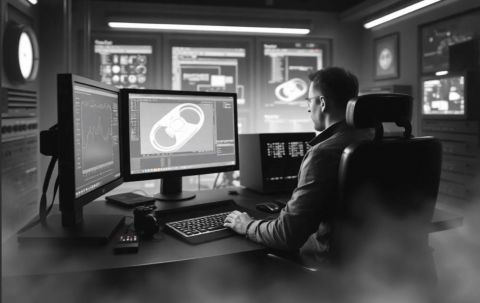Virtual Prototyping 101: A Beginner's Guide to Smarter Design

Your first prototype doesn’t need to be perfect—it needs to be virtual.
When I (Alex Gruber) first started my career in new product design, I thought success meant racing to build the "real thing" as quickly as possible. The excitement of seeing a physical model in hand often overshadowed the underlying costs.
But what I quickly learned is that physical prototypes, while essential at certain stages, can drain time, budget, and morale incredibly fast, especially if you're iterating frequently. The smarter, more efficient move? Embracing virtual prototyping through powerful simulation tools.
At Design Department Inc., we champion this approach, seeing it as fundamental to modern product development, particularly in the demanding MedTech and Consumer Products landscape. It’s about leveraging technology to gain insights that traditional methods simply can’t provide.
Here’s why virtual prototyping should be your new go-to:
1. Save Time: Digital Speed vs. Physical Delays
Once a robust base simulation model has been created, you can test countless design iterations digitally before the first physical part is ever made. We're talking about evaluating a completely new design or significant modification in days, rather than weeks or even months for physical fabrication and testing. This dramatic acceleration allows for a more comprehensive design exploration, leading to a superior final product faster.
2. Early Discovery: Uncovering Flaws Before They Cost You
Virtual prototypes allow you to stress-test your design ahead of time, simulating real-world conditions like temperature changes, impact forces, or material fatigue. It’s far better to know precisely where a design will fail—and why—in a digital environment, before incurring the expense and delay of a physical failure. This early discovery of potential issues is crucial for design risk reduction.
3. Career Edge: Elevating Your Engineering Impact
Growing your knowledge of how to leverage finite element analysis (FEA) and other advanced simulation-driven design tools makes you a stronger engineer and a more valuable teammate. These skills transform your approach from reactive problem-solving to proactive optimization, giving you a significant edge in today's competitive industry.
A few months back, I was working on a design that, in the CAD modeling environment, looked absolutely perfect. Every dimension, every tolerance, seemed spot-on. However, after creating a virtual prototype and running it through a load simulation, we realized there was a potential component interference that only showed up when the parts were under stress. A quick update to the product assembly in the virtual space—and we avoided what would have been an incredibly expensive lesson if discovered in the physical prototype stage. This kind of insight is invaluable.
Simulation is a tool, but it is an important tool that provides you with the opportunity to better understand and optimize your design up front. This gives you the confidence to walk into the physical prototyping stage knowing your design will work.
In today's fast-paced world of medical technology, you can't afford to leave your success to chance. Virtual prototyping isn't just a tool for us—it's a core philosophy that drives every project we undertake. We believe in engineering with confidence, not guesswork. At Design Department, we combine years of expertise with cutting-edge simulation to ensure your product is not only viable but exceptional, from the very first concept to the final prototype.
Ready to make every prototype count? Partner with us to bring your vision to life, smarter and faster.
